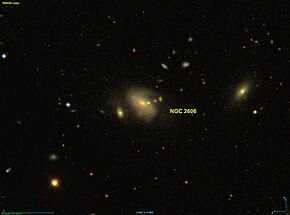| NGC 2606 | |
|---|---|
 A Sloan Digital Sky Survey (SDSS) image of NGC 2606 A Sloan Digital Sky Survey (SDSS) image of NGC 2606 | |
| Observation data (J2000 epoch) | |
| Constellation | Ursa Major |
| Right ascension | 08 35 34.5 |
| Declination | +52° 47′ 20″ |
| Redshift | 0.044341 ± 1.28e-5 |
| Distance | 646 Mly (198.08 Mpc) |
| Apparent magnitude (V) | 17.02 |
| Characteristics | |
| Type | Sab |
| Size | 232,000 ly |
| Apparent size (V) | 0.661′ × 0.339′ |
| Notable features | Type II Seyfert galaxy |
| Other designations | |
| PGC 24117, MCG+09-14-072, Z 263-59, LEDA 24117 | |
NGC 2606 is a spiral galaxy located around 646 million light-years away in the constellation Ursa Major. NGC 2606 was discovered on February 16th, 1831 by the astronomer John Herschel, and it has a diameter around 232,000 light-years. NGC 2606 is known to have some star-formation, and it is known to have an active galactic nucleus, specifically a Type II Seyfert galaxy.
References
- ^ "New General Catalog Objects: NGC 2600 - 2649". cseligman.com. Retrieved 2024-12-26.
- ^ "By Name | NASA/IPAC Extragalactic Database". ned.ipac.caltech.edu. Retrieved 2024-12-26.
- "NGC 2606 - Spiral Galaxy in Ursa Major | TheSkyLive.com". theskylive.com. Retrieved 2024-12-26.
- ^ "NGC 2603 - Galaxy - WIKISKY". wikisky.org. Retrieved 2024-12-26.
External links
 Media related to NGC 2606 at Wikimedia Commons
Media related to NGC 2606 at Wikimedia Commons